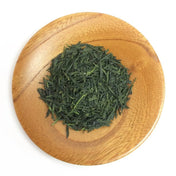In the previous article , I showed you how to make hojicha from green tea. In this article, I'll show you a few roasting experiments with some different types of green tea in my cupboard, which had lost some flavor over time, since the packets were opened.
Experiment 1: Roasting two types of Sencha Green Tea
For this experiment, I'm going to roast 2 types of sencha green tea shown below, and compare how the roastings go and what they taste like.
Tea Type
1 Deep-steamed Sencha Green Tea
Deep-steamed sencha green tea, fukamushicha in Japanese, where the leaves are steamed longer (for 1-3 minutes) than as usual, and as a result, the tea leaves become more powdery and the color of the tea becomes deeper-green with rich flavor.

Deep-steamed sencha green tea
This tea is made from spring harvested tea leaves. Tea leaves are usually picked 2-3 times in a year, the first flush in spring, summer and autumn. Spring tea leaves are thinner and softer than other season's leaves, and have got fresh flavor and umami savoriness.
2 Summer Harvested Sencha Green Tea
Tea leaves harvested in summer are used for this tea.The tea leaves are thicker than spring harvested leaves as they grow under the bright sunlight. It has some sharp astringency and aroma, but also with some sweetness.

Summer harvested sencha green tea
Roasting Method
Following the instructions in the previous article, I sifted both types of tea and roasted them on low heat as much as possible with a pan, and took them off the heat before getting burnt.
Result
1 Deep-steamed Sencha Green Tea

This was roasted on low heat for 9 minutes. I had to be careful not to roast too much, as the leaves seemed to fall apart and get burnt easily.
2 Summer Harvested Sencha Green Tea

This was roasted on low heat for 13 minutes. It was easier to roast, compared to the deep-steamed tea, as the leaves were thick and strong.
The Taste Comparison
4g of tea each was steeped with 200ml water at 90 ℃ 194°/ F for 1 minute. Hojicha with deep-steamed tea tasted sharper than hojicha with summer harvested tea, and it still had the green tea flavor aftertaste. I felt hojicha with deep-steamed tea tasted like the premium type of hojicha and also light-roast type in stores.
Hojicha with summer harvested tea had a mild taste, and also had a sweet flavor like chocolate. It tasted like a dark-roast type of hojicha in stores.
Question
I was happy to make hojicha, and both of the taste were very good, but I've had a thought about deep-steamed tea hojicha. At the beginning, when I was sifting, many powdery tea leaves were left in the tray, as the tea contained many small leaves. How could I use this tea powder?

Then, there was a question that came to mind.
"What happens if I make hojicha without sifting?"
Experiment 2 : Roasting without Sifting
I decided to repeat the experiment using the same deep-steamed tea. The method for making hojicha is exactly the same as the experiment 1 except without sifting. I roasted the tea as much as possible with a pan on low heat, and took them off the heat before getting burnt.

Result
3 Deep-steamed Sencha Green Tea without Sifting

I roasted it on low heat for 6 minutes, which I think was the maximum to avoid burning.
The Taste
Bigger pieces such as tea stems or tea leaves still remains the green tea flavor as they're not heated so much. The fine pieces got toasty flavor like dark roast type of Hojicha. So, it tastes like a mixture of very light roast type of Hojicha such as Green Hojicha and dark roast type of Hojicha. I can say it has a good balance of the green tea flavor and roasted tea flavor.
Conclusion
Which Hojicha Tastes the Best?

Hojicha with 1 deep-steamed tea with sifting (left), 2 summer harvested tea with sifting (center), 3 deep-steamed tea without sifting (right)
I think any of these hojicha tastes nice. Which one you prefer, of course, depends on your person preference. I prefer summer harvested tea as I like the mild and dark-roast type of hojicha. Others may chose different ones. You can enjoy iced tea with all of them as well as enjoying the usual hot tea. If you'd like to make hojicha latte, I recommend you roast summer harvested tea. The taste goes very well with milk.
Which Green tea is Easier to Make Hojicha?
At the point of making a delicious hojicha, stopping roasting before getting burnt is very important, as burnt taste kills the green tea flavor and the nice aroma.
You therefore have to roast leaves carefully as they can easily get burnt, so large-leaved summer harvested tea are easier to roast. Large- leaved tea, such as summer harvested tea, archa, and kukicha (leaf stem tea) will be easier to make hojicha.
Do We Really Need Sifting?
I think you can choose if you sift or not. Sifting will make the roasting easier and roast all of the leaves equally, but you can also make hojicha without sifting. It may not look perfect and some leaves won't be roasted enough, but you can enjoy the blend of green tea and dark-roast flavors. Also it's easy to make and no waste! Try and find your favorite way.
I enjoyed making hojicha at home, and I'd love you to experience the nice roast aroma by making some, too!
Related articles
How to Reinvigorate Your Green Tea - Hojicha Roasting
Hojicha Steeping Information

Use 4g of hojicha with 200ml of hot water at 90℃°/194F, steep for 1 minute.
How to Use the Leftover tea after Sifting
Make Green tea salt.

Today's Recommendations
Japanese Green Tea Set
Yunomi Dojo Lesson 105: 12 Japanese Green Teas Variety Set
Try this set if you would like to know different types of Japanese green tea. This set offers Gyokuro, Kabusecha, Sencha, Fukamushicha, Kukicha, Mecha, Konacha, Hojicha, Genmaicha, Aracha, Bancha, and Tencha selected by Yunomi staff!
Spring Harvested Hojicha
NaturaliTea #09: Superior Hojicha Roasted Green Tea (Spring Harvest) 上ほうじ茶
Ichibancha(first harvest) leaves were used and roasted carefully at a high temperature.
Autumn Harvested Hojicha
Tarui Tea Farm: Organic Autumn Hojicha, Roasted Shizuoka Green Tea
The leaves harvested in late September - early October gave some sweetness in this hojicha.
Hojicha Recipes
How to Make a Delicious Cup of Hojicha Milk (Hojicha Latte)
Tea Marinated Pork - Hojicha Roast Pork Recipe -


